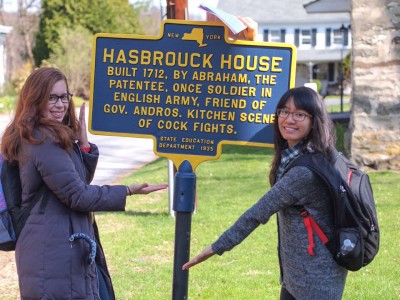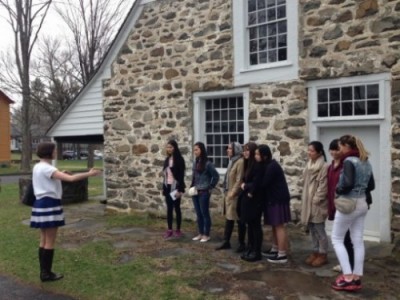“Learning the Culture with My Own Eyes”
A Unit on Local History for English Language Learners
“As an English learner in America, I have strong passion in studying what I see. I like to learn the culture with my own eyes.” — Qing Wang, an English language student from China at the State University of New York (SUNY) at New Paltz
In the spring of 2014, Historic Huguenot Street (HHS), a nonprofit organization in New Paltz, New York, began to offer SUNY New Paltz students free one-year memberships. Membership gives students the privilege of taking free guided tours and attending educational events, as well as discounts to other programs about the town.
New Paltz, located 80 miles north of New York City, was settled in the 17th century by French Huguenots, followers of Protestant theologian John Calvin who sought safety from persecution by fleeing to America. After the English government granted them a 30,000-acre parcel that stretched from the Hudson River to the Shawangunk Mountains, they established their community on the banks of the Wallkill River. Today, many of the early homes remain on Huguenot Street, within walking distance from the SUNY New Paltz campus.

Greice Oliveira, an electrical engineering major from Brazil, and Kojima Konatsu, a medical student from Japan, stand in front of a Hasbrouk House’s historic marker.
In the past two years, English-language learners at SUNY New Paltz benefited from their HHS memberships in the advanced English classes I taught. My students, majoring in various academic fields, come primarily from Asia, South America, and the Middle East. Some of them are studying on exchange, while others plan to seek an academic degree in the US. One thing they all have in common is an interest in improving their academic language skills. Growing up with my father, a high school social studies teacher, and my mother, a local historian, I have always appreciated history, so I devised a unit on local history to help my students prepare for future academic coursework. The unit is focused around a research project and two walking trips to Historic Huguenot Street.
First, students read articles about the history of New Paltz and the settlement of Huguenot Street, compiling information from their readings and questions to ask the HHS tour guide during our visit at the end of the unit. As they work on this project, students develop their language skills by incorporating new vocabulary in their responses to the academic texts. Qing Wang, a student from China, reflected, “Reading articles about Huguenot Street expanded my vocabulary. I learned how to skim articles and find the main ideas at the same time. The more I read complex articles, the more I made progress in reading speed.” Students incorporate key terms in their summary assignments including words like cellar, outbuilding, manumission, miscegenation, heritage, and Protestant. Throughout the unit, students create a vocabulary list, repeat these words in discussions and writings, and are given short quizzes.
After students have a basic understanding of the local New Paltz history, each student chooses one topic to focus his or her research on; topics include historic homes, the original church, cemeteries, Native Americans, and slavery. Using their research, students become “experts” on their individual topics. “I focused on slaves’ burial grounds,” Wang recalled, relating some of the more disturbing details of the burial grounds’ history. “Their remains had just been thrown into the ground and were not buried deep. Recently, people made a monument to mark the area, and this African American burial ground is now someone’s front yard.”
During the first visit to HHS, we walk around carrying maps and stopping at each building or historic plot of land. Students take turns presenting using the information they researched and answering their classmates’ questions. They include a sociocultural comparison between the early history of New Paltz and their home country. For example, Wang discussed slave life in New Paltz and some details about slave life in her home region of China.
The second visit to HHS, and the culmination of the unit, includes an official tour. We begin at the visitors’ center, where we watch a film about the early history of New Paltz. Even if the students do not understand all of the language in the film, the visual context gives them a feeling for the sights and sounds of the era.
We then tour several historic homes, led by HHS interpreters. At the end of each tour, students ask guides questions from the lists that they created during their research. For example, “Do descendants of the original slaves in New Paltz come back to Huguenot Street to remember their ancestors’ history?”

Kristine Gogg, Sales & Tours Manager at Historic Huguenot Street, talking to Qing Wang (far left) and her classmates about the slave quarters of the Bevier-Elting House.
If tour guides do not understand a student because of his or her accent, they ask for clarification. This is a good opportunity for the students to practice communicating with native speakers.
After our two visits to HHS, students write essays on the history of New Paltz, including a comparison of the method of studying history in their cultures, and a reflection on their experience. The culminating group task is to make a short video incorporating research, vocabulary, photographs, and footage of the local area.
“I felt happy to use fun ways to share what I learned, and I think making a video can be a quick way to help people understand the history,” Wang said. “After this unit, I felt New Paltz is a town with a thick atmosphere of history and there are more mysteries of Huguenot Street waiting for people to realize.”
Studying local history in this way allows for an engaging process of learning English. I look forward to bringing students to HHS in coming semesters and hope to inspire more to explore local history.
Sarah Elia is a lecturer in the Haggerty English Language Program at SUNY New Paltz and a frequent presenter at International TESOL. Her research interests include educational technology, cross-cultural studies, and teacher training. She has a BA in music from Bard College and an MS in TESOL from SUNY New Paltz.
This post first appeared on AHA Today.
Tags: AHA Today Public History Teaching Resources and Strategies
Comment
Please read our commenting and letters policy before submitting.








